engine HYUNDAI I20 2022 Owners Manual
[x] Cancel search | Manufacturer: HYUNDAI, Model Year: 2022, Model line: I20, Model: HYUNDAI I20 2022Pages: 444, PDF Size: 8.93 MB
Page 263 of 444
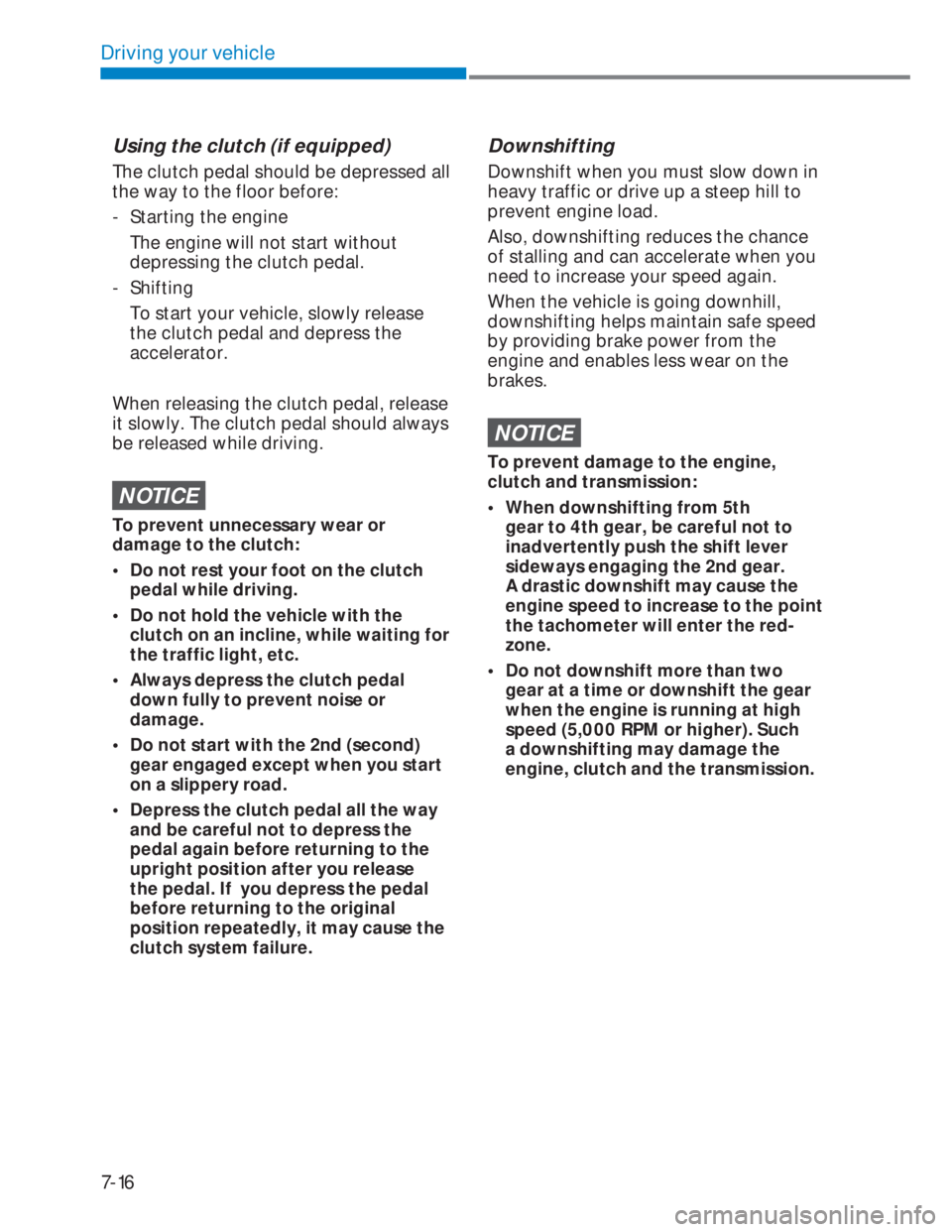
7-16
Driving your vehicle
Using the clutch (if equipped)
The clutch pedal should be depressed all
the way to the floor before:
- Starting the engine
The engine will not start without
depressing the clutch pedal.
- Shifting
To start your vehicle, slowly release
the clutch pedal and depress the
accelerator.
When releasing the clutch pedal, release
it slowly. The clutch pedal should always
be released while driving.
NOTICE
To prevent unnecessary wear or
damage to the clutch:
• Do not rest your foot on the clutch
pedal while driving.
• Do not hold the vehicle with the
clutch on an incline, while waiting for
the traffic light, etc.
• Always depress the clutch pedal
down fully to prevent noise or
damage.
• Do not start with the 2nd (second)
gear engaged except when you start
on a slippery road.
• Depress the clutch pedal all the way
and be careful not to depress the
pedal again before returning to the
upright position after you release
the pedal. If you depress the pedal
before returning to the original
position repeatedly, it may cause the
clutch system failure.
Downshifting
Downshift when you must slow down in
heavy traffic or drive up a steep hill to
prevent engine load.
Also, downshifting reduces the chance
of stalling and can accelerate when you
need to increase your speed again.
When the vehicle is going downhill,
downshifting helps maintain safe speed
by providing brake power from the
engine and enables less wear on the
brakes.
NOTICE
To prevent damage to the engine,
clutch and transmission:
• When downshifting from 5th
gear to 4th gear, be careful not to
inadvertently push the shift lever
sideways engaging the 2nd gear.
A drastic downshift may cause the
engine speed to increase to the point
the tachometer will enter the red-
zone.
• Do not downshift more than two
gear at a time or downshift the gear
when the engine is running at high
speed (5,000 RPM or higher). Such
a downshifting may damage the
engine, clutch and the transmission.
Page 264 of 444
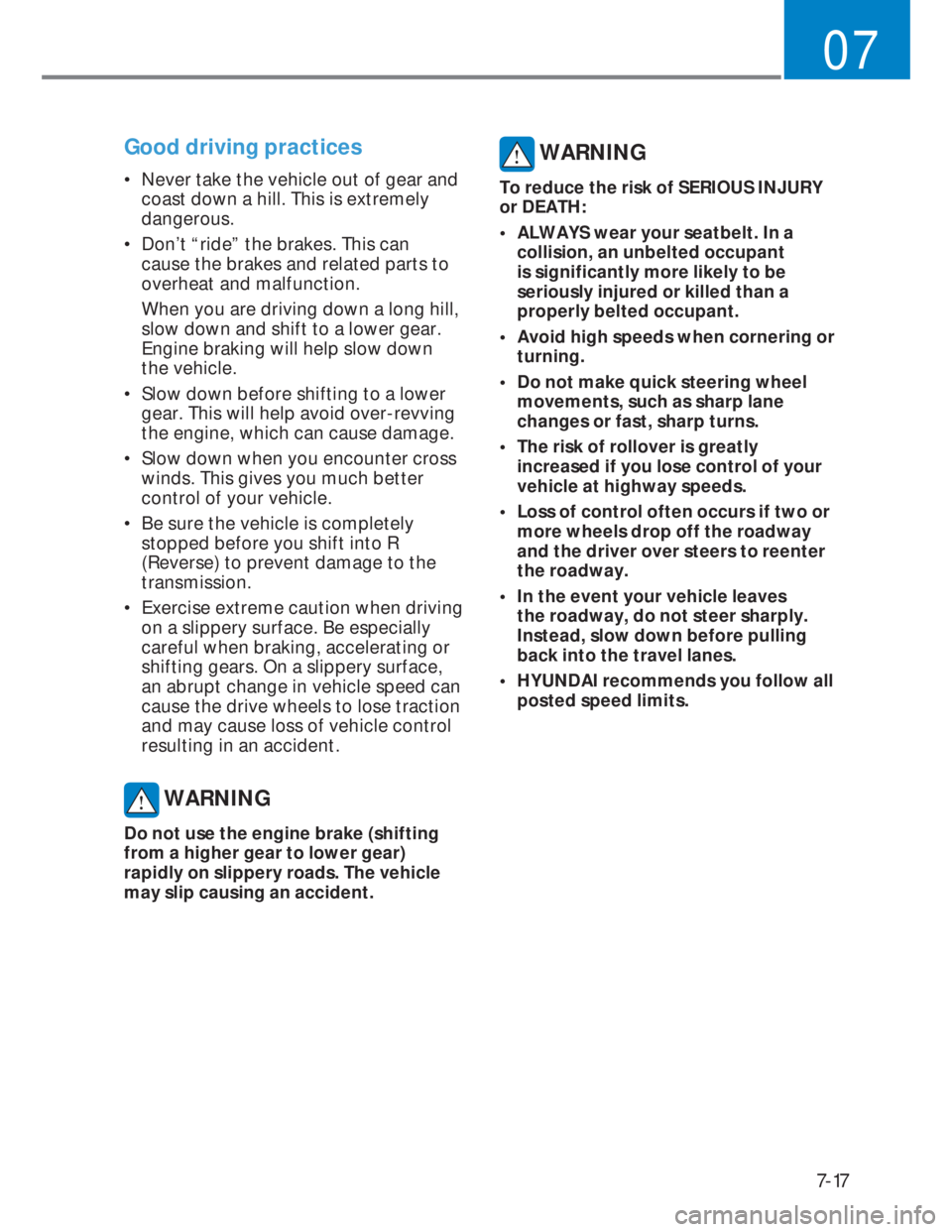
7-17
07
Good driving practices
• Never take the vehicle out of gear and
coast down a hill. This is extremely
dangerous.
• Don’t “ride” the brakes. This can
cause the brakes and related parts to
overheat and malfunction.
When you are driving down a long hill,
slow down and shift to a lower gear.
Engine braking will help slow down
the vehicle.
• Slow down before shifting to a lower
gear. This will help avoid over-revving
the engine, which can cause damage.
• Slow down when you encounter cross
winds. This gives you much better
control of your vehicle.
• Be sure the vehicle is completely
stopped before you shift into R
(Reverse) to prevent damage to the
transmission.
• Exercise extreme caution when driving
on a slippery surface. Be especially
careful when braking, accelerating or
shifting gears. On a slippery surface,
an abrupt change in vehicle speed can
cause the drive wheels to lose traction
and may cause loss of vehicle control
resulting in an accident.
WARNING
Do not use the engine brake (shifting
from a higher gear to lower gear)
rapidly on slippery roads. The vehicle
may slip causing an accident.
WARNING
To reduce the risk of SERIOUS INJURY
or DEATH:
• ALWAYS wear your seatbelt. In a
collision, an unbelted occupant
is significantly more likely to be
seriously injured or killed than a
properly belted occupant.
• Avoid high speeds when cornering or
turning.
• Do not make quick steering wheel
movements, such as sharp lane
changes or fast, sharp turns.
• The risk of rollover is greatly
increased if you lose control of your
vehicle at highway speeds.
• Loss of control often occurs if two or
more wheels drop off the roadway
and the driver over steers to reenter
the roadway.
• In the event your vehicle leaves
the roadway, do not steer sharply.
Instead, slow down before pulling
back into the travel lanes.
• HYUNDAI recommends you follow all
posted speed limits.
Page 266 of 444
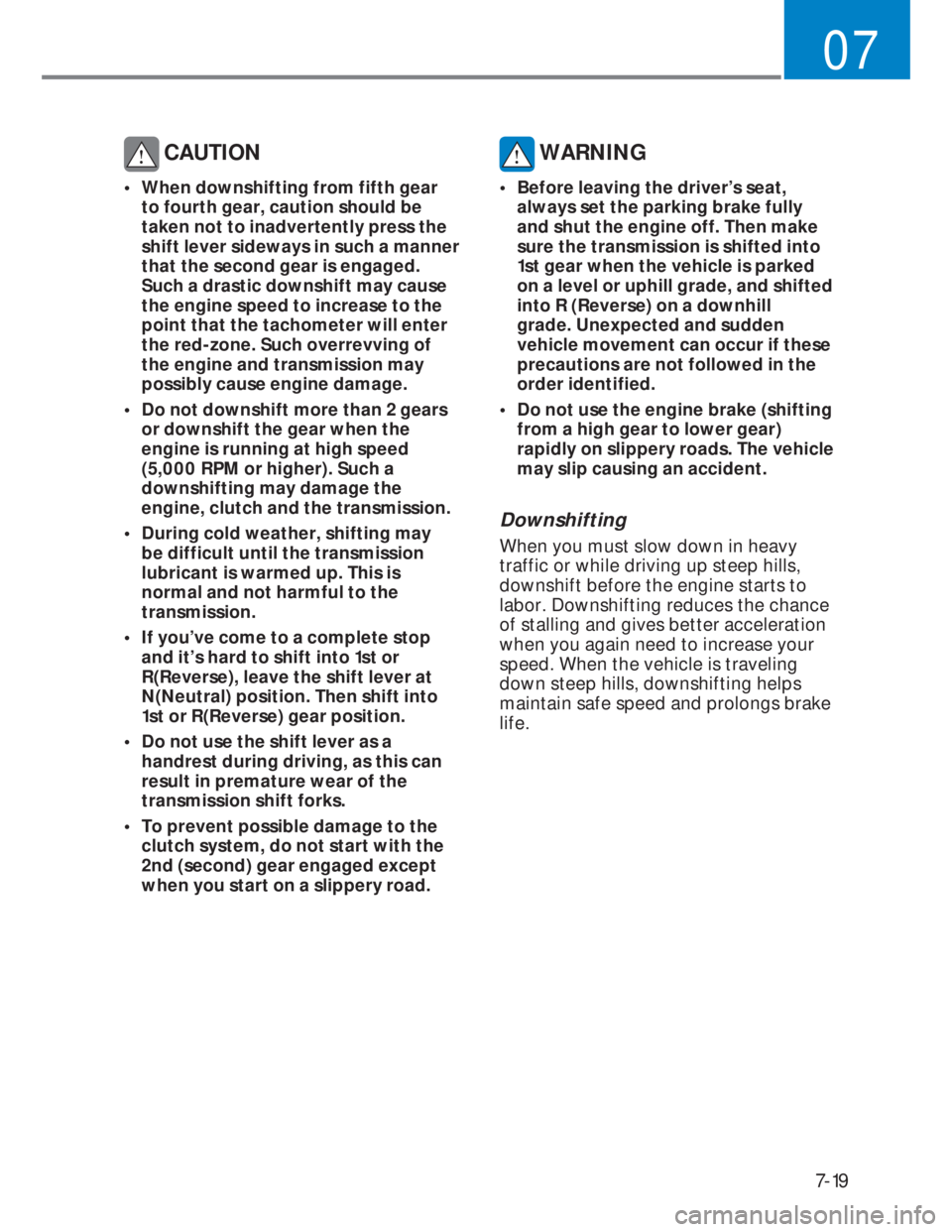
7-19
07
CAUTION
• When downshifting from fifth gear
to fourth gear, caution should be
taken not to inadvertently press the
shift lever sideways in such a manner
that the second gear is engaged.
Such a drastic downshift may cause
the engine speed to increase to the
point that the tachometer will enter
the red-zone. Such overrevving of
the engine and transmission may
possibly cause engine damage.
• Do not downshift more than 2 gears
or downshift the gear when the
engine is running at high speed
(5,000 RPM or higher). Such a
downshifting may damage the
engine, clutch and the transmission.
• During cold weather, shifting may
be difficult until the transmission
lubricant is warmed up. This is
normal and not harmful to the
transmission.
• If you’ve come to a complete stop
and it’s hard to shift into 1st or
R(Reverse), leave the shift lever at
N(Neutral) position. Then shift into
1st or R(Reverse) gear position.
• Do not use the shift lever as a
handrest during driving, as this can
result in premature wear of the
transmission shift forks.
• To prevent possible damage to the
clutch system, do not start with the
2nd (second) gear engaged except
when you start on a slippery road.
WARNING
• Before leaving the driver’s seat,
always set the parking brake fully
and shut the engine off. Then make
sure the transmission is shifted into
1st gear when the vehicle is parked
on a level or uphill grade, and shifted
into R (Reverse) on a downhill
grade. Unexpected and sudden
vehicle movement can occur if these
precautions are not followed in the
order identified.
• Do not use the engine brake (shifting
from a high gear to lower gear)
rapidly on slippery roads. The vehicle
may slip causing an accident.
Downshifting
When you must slow down in heavy
traffic or while driving up steep hills,
downshift before the engine starts to
labor. Downshifting reduces the chance
of stalling and gives better acceleration
when you again need to increase your
speed. When the vehicle is traveling
down steep hills, downshifting helps
maintain safe speed and prolongs brake
life.
Page 267 of 444
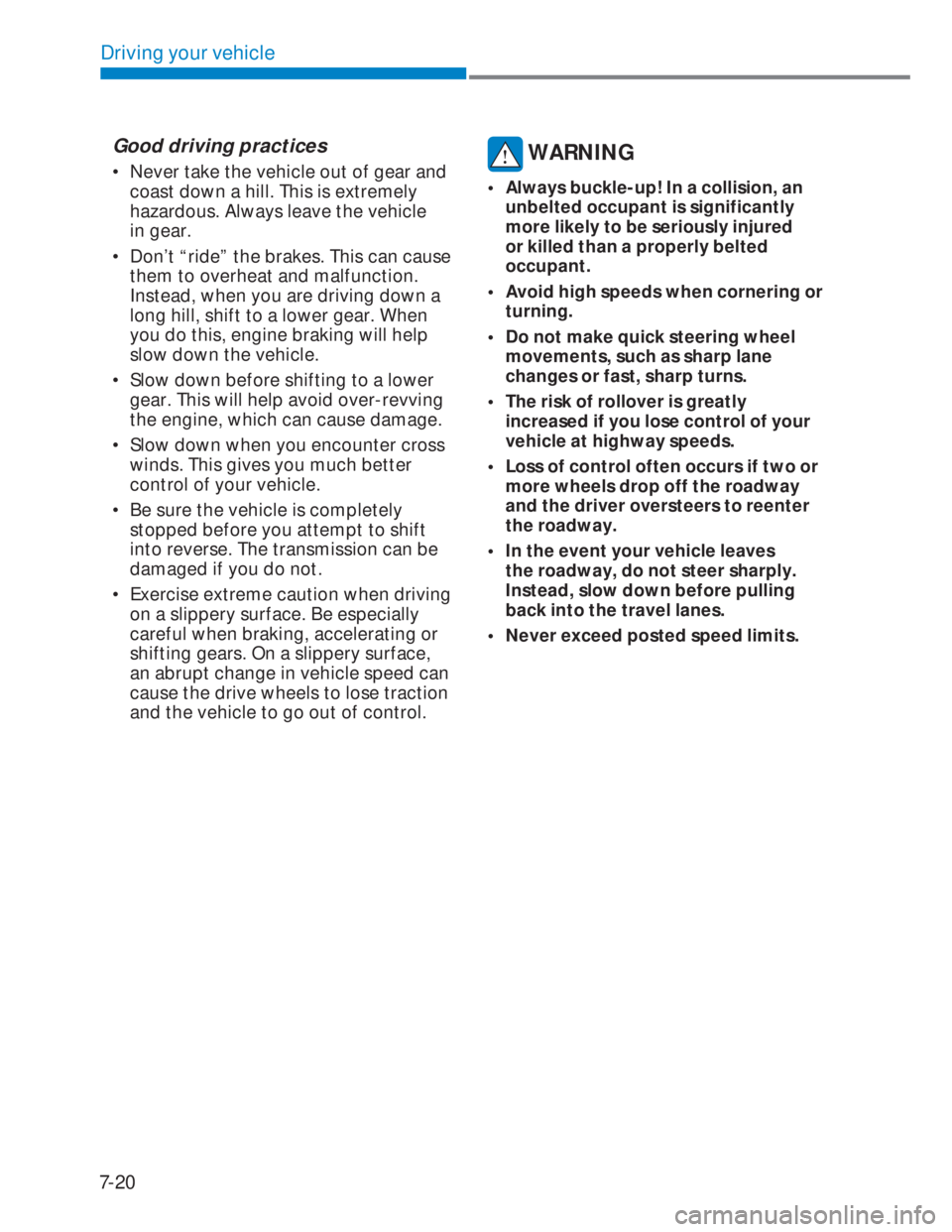
7-20
Driving your vehicle
Good driving practices
• Never take the vehicle out of gear and
coast down a hill. This is extremely
hazardous. Always leave the vehicle
in gear.
• Don’t “ride” the brakes. This can cause
them to overheat and malfunction.
Instead, when you are driving down a
long hill, shift to a lower gear. When
you do this, engine braking will help
slow down the vehicle.
• Slow down before shifting to a lower
gear. This will help avoid over-revving
the engine, which can cause damage.
• Slow down when you encounter cross
winds. This gives you much better
control of your vehicle.
• Be sure the vehicle is completely
stopped before you attempt to shift
into reverse. The transmission can be
damaged if you do not.
• Exercise extreme caution when driving
on a slippery surface. Be especially
careful when braking, accelerating or
shifting gears. On a slippery surface,
an abrupt change in vehicle speed can
cause the drive wheels to lose traction
and the vehicle to go out of control.
WARNING
• Always buckle-up! In a collision, an
unbelted occupant is significantly
more likely to be seriously injured
or killed than a properly belted
occupant.
• Avoid high speeds when cornering or
turning.
• Do not make quick steering wheel
movements, such as sharp lane
changes or fast, sharp turns.
• The risk of rollover is greatly
increased if you lose control of your
vehicle at highway speeds.
• Loss of control often occurs if two or
more wheels drop off the roadway
and the driver oversteers to reenter
the roadway.
• In the event your vehicle leaves
the roadway, do not steer sharply.
Instead, slow down before pulling
back into the travel lanes.
• Never exceed posted speed limits.
Page 269 of 444
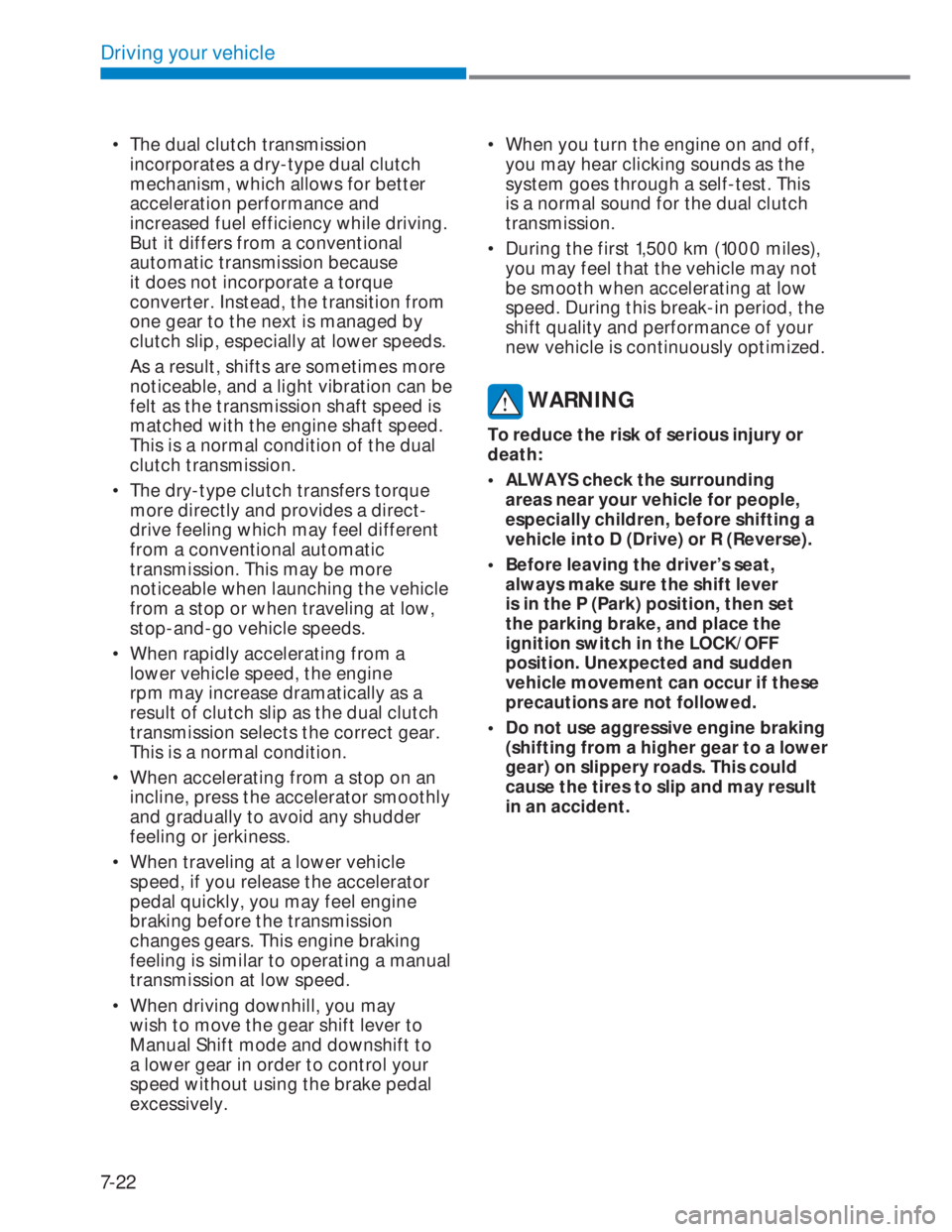
7-22
Driving your vehicle
• The dual clutch transmission
incorporates a dry-type dual clutch
mechanism, which allows for better
acceleration performance and
increased fuel efficiency while driving.
But it differs from a conventional
automatic transmission because
it does not incorporate a torque
converter. Instead, the transition from
one gear to the next is managed by
clutch slip, especially at lower speeds.
As a result, shifts are sometimes more
noticeable, and a light vibration can be
felt as the transmission shaft speed is
matched with the engine shaft speed.
This is a normal condition of the dual
clutch transmission.
• The dry-type clutch transfers torque
more directly and provides a direct-
drive feeling which may feel different
from a conventional automatic
transmission. This may be more
noticeable when launching the vehicle
from a stop or when traveling at low,
stop-and-go vehicle speeds.
• When rapidly accelerating from a
lower vehicle speed, the engine
rpm may increase dramatically as a
result of clutch slip as the dual clutch
transmission selects the correct gear.
This is a normal condition.
• When accelerating from a stop on an
incline, press the accelerator smoothly
and gradually to avoid any shudder
feeling or jerkiness.
• When traveling at a lower vehicle
speed, if you release the accelerator
pedal quickly, you may feel engine
braking before the transmission
changes gears. This engine braking
feeling is similar to operating a manual
transmission at low speed.
• When driving downhill, you may
wish to move the gear shift lever to
Manual Shift mode and downshift to
a lower gear in order to control your
speed without using the brake pedal
excessively.• When you turn the engine on and off,
you may hear clicking sounds as the
system goes through a self-test. This
is a normal sound for the dual clutch
transmission.
• During the first 1,500 km (1000 miles),
you may feel that the vehicle may not
be smooth when accelerating at low
speed. During this break-in period, the
shift quality and performance of your
new vehicle is continuously optimized.
WARNING
To reduce the risk of serious injury or
death:
• ALWAYS check the surrounding
areas near your vehicle for people,
especially children, before shifting a
vehicle into D (Drive) or R (Reverse).
• Before leaving the driver’s seat,
always make sure the shift lever
is in the P (Park) position, then set
the parking brake, and place the
ignition switch in the LOCK/OFF
position. Unexpected and sudden
vehicle movement can occur if these
precautions are not followed.
• Do not use aggressive engine braking
(shifting from a higher gear to a lower
gear) on slippery roads. This could
cause the tires to slip and may result
in an accident.
Page 271 of 444
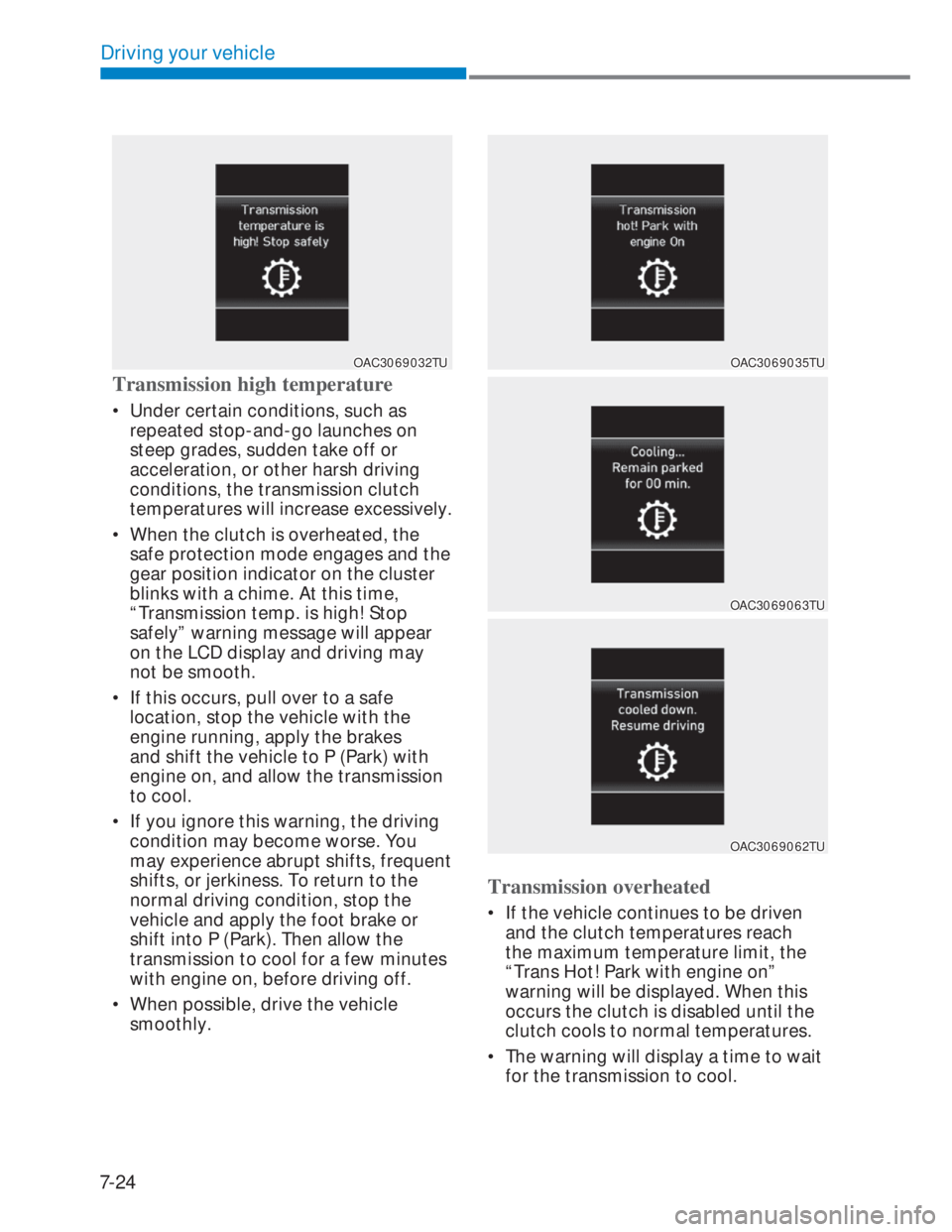
7-24
Driving your vehicle
OAC3069032TUOAC3069032TU
Transmission high temperature
• Under certain conditions, such as
repeated stop-and-go launches on
steep grades, sudden take off or
acceleration, or other harsh driving
conditions, the transmission clutch
temperatures will increase excessively.
• When the clutch is overheated, the
safe protection mode engages and the
gear position indicator on the cluster
blinks with a chime. At this time,
“Transmission temp. is high! Stop
safely” warning message will appear
on the LCD display and driving may
not be smooth.
• If this occurs, pull over to a safe
location, stop the vehicle with the
engine running, apply the brakes
and shift the vehicle to P (Park) with
engine on, and allow the transmission
to cool.
• If you ignore this warning, the driving
condition may become worse. You
may experience abrupt shifts, frequent
shifts, or jerkiness. To return to the
normal driving condition, stop the
vehicle and apply the foot brake or
shift into P (Park). Then allow the
transmission to cool for a few minutes
with engine on, before driving off.
• When possible, drive the vehicle
smoothly.
OAC3069035TUOAC3069035TU
OAC3069063TUOAC3069063TU
OAC3069062TUOAC3069062TU
Transmission overheated
• If the vehicle continues to be driven
and the clutch temperatures reach
the maximum temperature limit, the
“Trans Hot! Park with engine on”
warning will be displayed. When this
occurs the clutch is disabled until the
clutch cools to normal temperatures.
• The warning will display a time to wait
for the transmission to cool.
Page 272 of 444
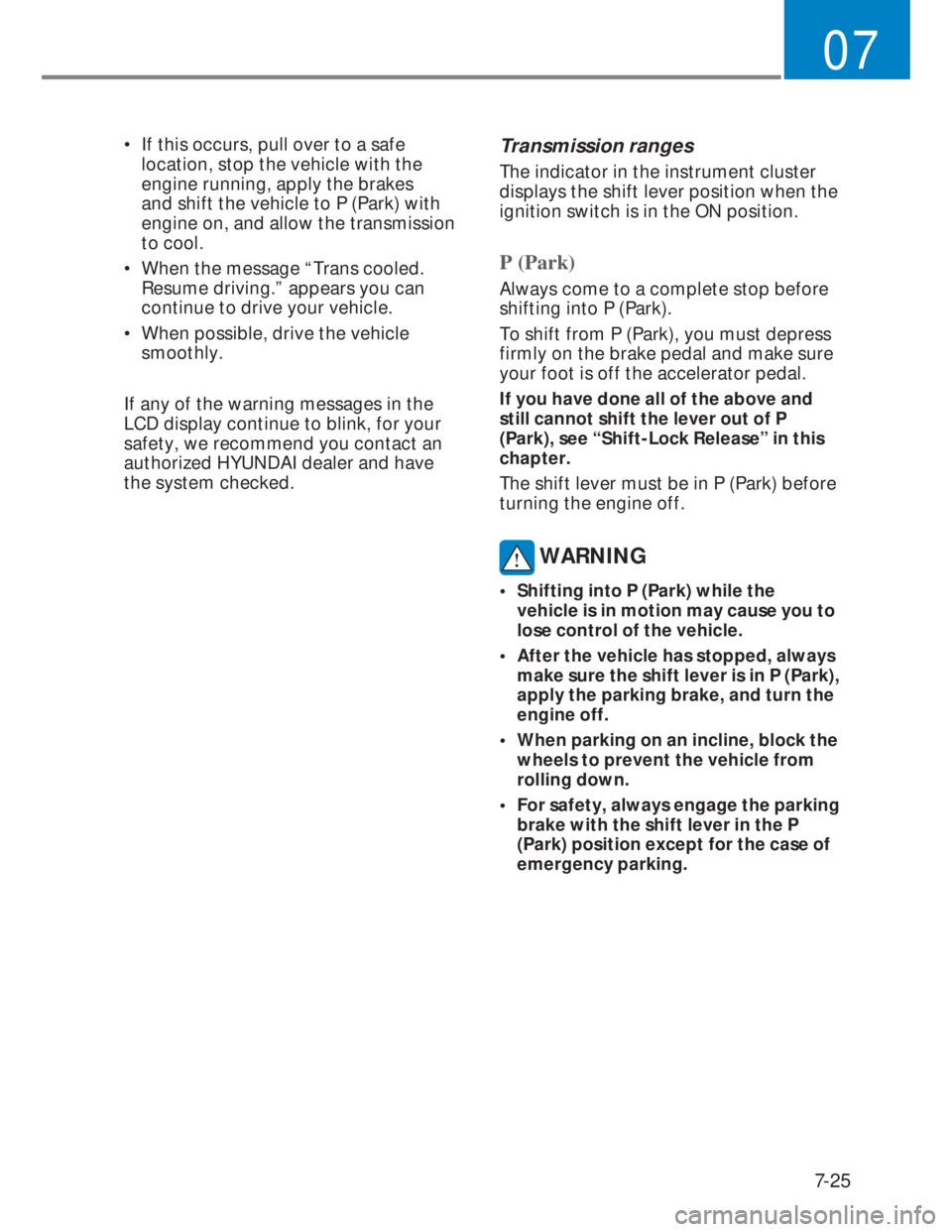
7-25
07
• If this occurs, pull over to a safe
location, stop the vehicle with the
engine running, apply the brakes
and shift the vehicle to P (Park) with
engine on, and allow the transmission
to cool.
• When the message “Trans cooled.
Resume driving.” appears you can
continue to drive your vehicle.
• When possible, drive the vehicle
smoothly.
If any of the warning messages in the
LCD display continue to blink, for your
safety, we recommend you contact an
authorized HYUNDAI dealer and have
the system checked.Transmission ranges
The indicator in the instrument cluster
displays the shift lever position when the
ignition switch is in the ON position.
P (Park)
Always come to a complete stop before
shifting into P (Park).
To shift from P (Park), you must depress
firmly on the brake pedal and make sure
your foot is off the accelerator pedal.
If you have done all of the above and
still cannot shift the lever out of P
(Park), see “Shift-Lock Release” in this
chapter.
The shift lever must be in P (Park) before
turning the engine off.
WARNING
• Shifting into P (Park) while the
vehicle is in motion may cause you to
lose control of the vehicle.
• After the vehicle has stopped, always
make sure the shift lever is in P (Park),
apply the parking brake, and turn the
engine off.
• When parking on an incline, block the
wheels to prevent the vehicle from
rolling down.
• For safety, always engage the parking
brake with the shift lever in the P
(Park) position except for the case of
emergency parking.
Page 273 of 444
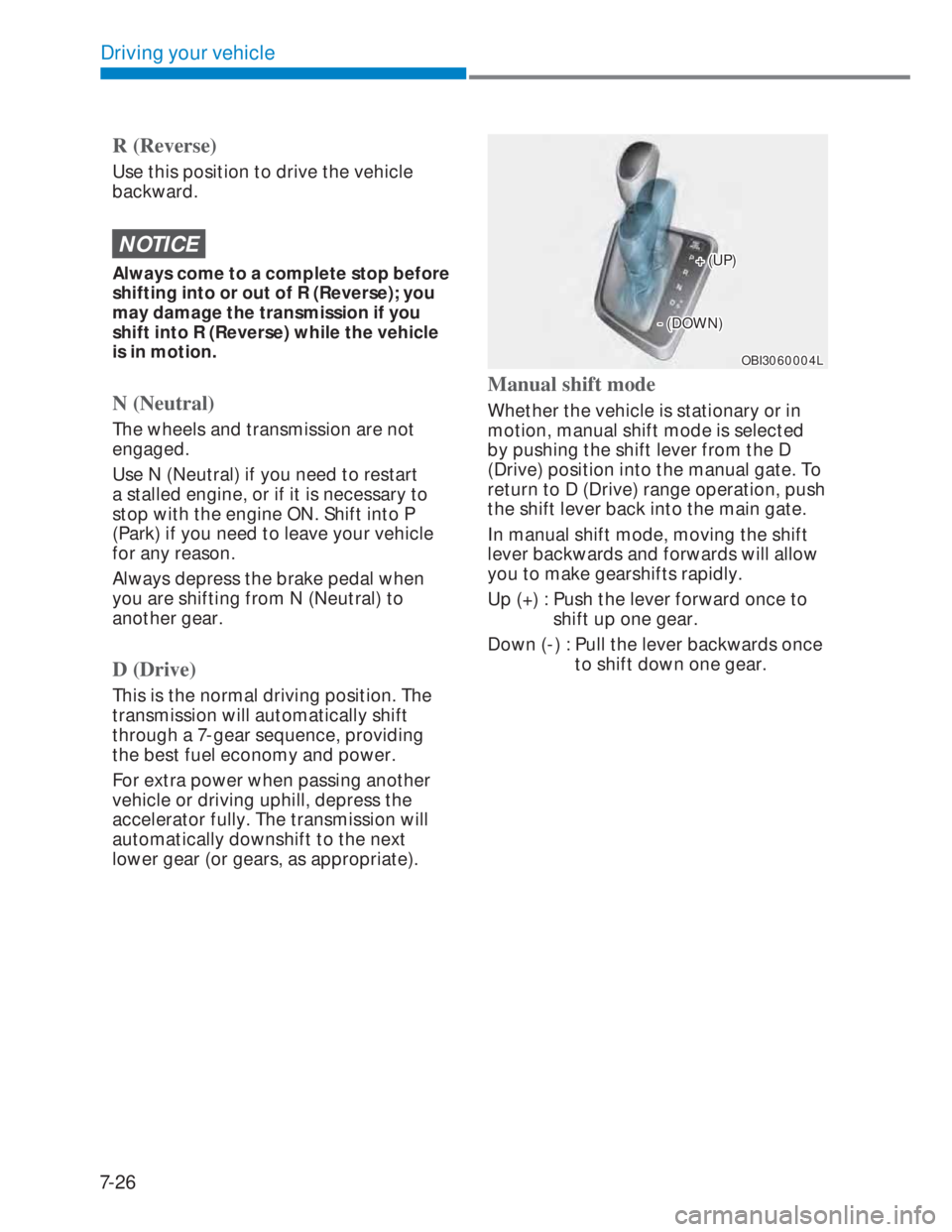
7-26
Driving your vehicle
R (Reverse)
Use this position to drive the vehicle
backward.
NOTICE
Always come to a complete stop before
shifting into or out of R (Reverse); you
may damage the transmission if you
shift into R (Reverse) while the vehicle
is in motion.
N (Neutral)
The wheels and transmission are not
engaged.
Use N (Neutral) if you need to restart
a stalled engine, or if it is necessary to
stop with the engine ON. Shift into P
(Park) if you need to leave your vehicle
for any reason.
Always depress the brake pedal when
you are shifting from N (Neutral) to
another gear.
D (Drive)
This is the normal driving position. The
transmission will automatically shift
through a 7-gear sequence, providing
the best fuel economy and power.
For extra power when passing another
vehicle or driving uphill, depress the
accelerator fully. The transmission will
automatically downshift to the next
lower gear (or gears, as appropriate).
OBI3060004LOBI3060004L
+ (UP)+ (UP)
- (DOWN)- (DOWN)
Manual shift mode
Whether the vehicle is stationary or in
motion, manual shift mode is selected
by pushing the shift lever from the D
(Drive) position into the manual gate. To
return to D (Drive) range operation, push
the shift lever back into the main gate.
In manual shift mode, moving the shift
lever backwards and forwards will allow
you to make gearshifts rapidly.
Up (+) : Push the lever forward once to
shift up one gear.
Down (-) : Pull the lever backwards once
to shift down one gear.
Page 274 of 444
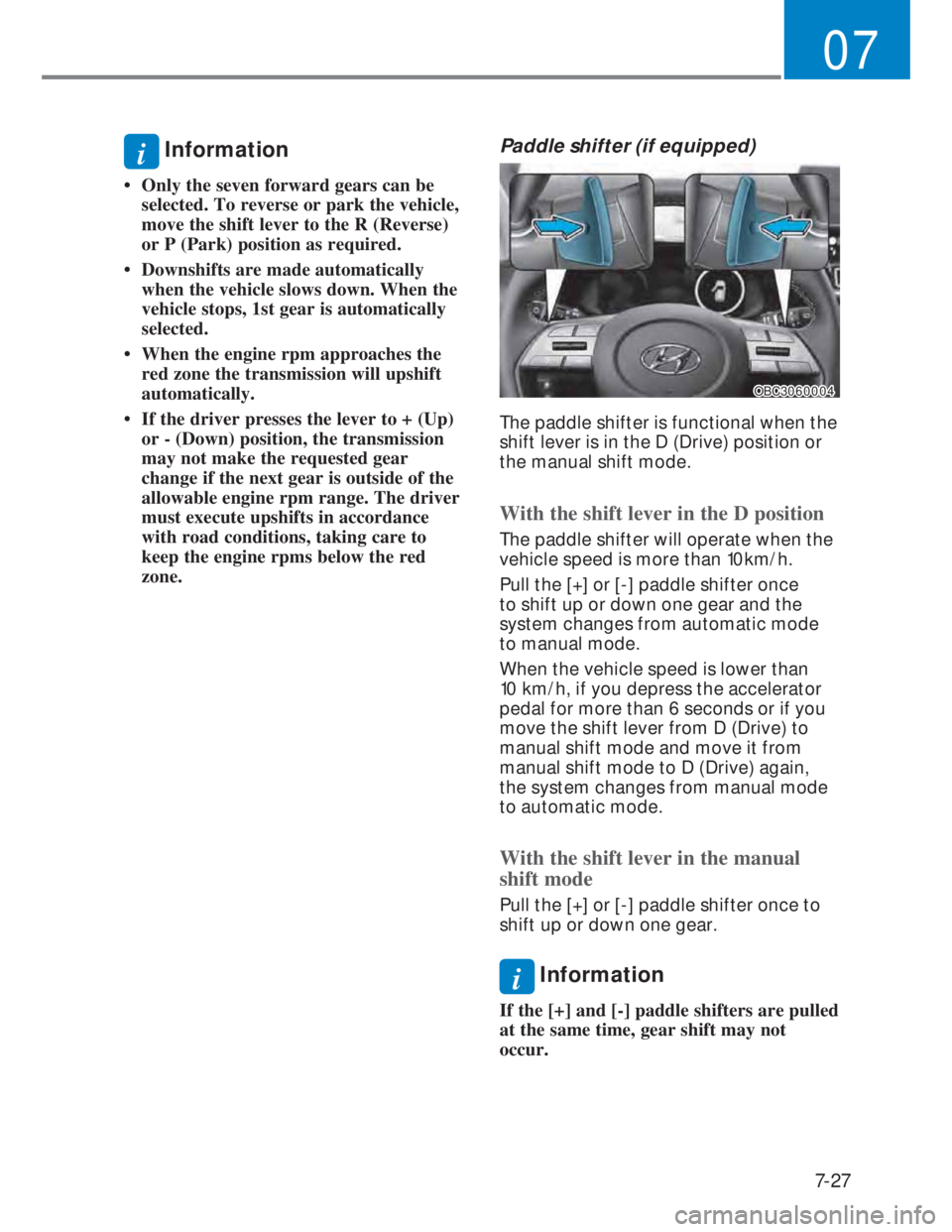
7-27
07
i Information
• Only the seven forward gears can be
selected. To reverse or park the vehicle,
move the shift lever to the R (Reverse)
or P (Park) position as required.
• Downshifts are made automatically
when the vehicle slows down. When the
vehicle stops, 1st gear is automatically
selected.
• When the engine rpm approaches the
red zone the transmission will upshift
automatically.
• If the driver presses the lever to + (Up)
or - (Down) position, the transmission
may not make the requested gear
change if the next gear is outside of the
allowable engine rpm range. The driver
must execute upshifts in accordance
with road conditions, taking care to
keep the engine rpms below the red
zone.
Paddle shifter (if equipped)
OBC3060004OBC3060004
The paddle shifter is functional when the
shift lever is in the D (Drive) position or
the manual shift mode.
With the shift lever in the D position
The paddle shifter will operate when the
vehicle speed is more than 10km/h.
Pull the [+] or [-] paddle shifter once
to shift up or down one gear and the
system changes from automatic mode
to manual mode.
When the vehicle speed is lower than
10 km/h, if you depress the accelerator
pedal for more than 6 seconds or if you
move the shift lever from D (Drive) to
manual shift mode and move it from
manual shift mode to D (Drive) again,
the system changes from manual mode
to automatic mode.
With the shift lever in the manual
shift mode
Pull the [+] or [-] paddle shifter once to
shift up or down one gear.
i Information
If the [+] and [-] paddle shifters are pulled
at the same time, gear shift may not
occur.
Page 275 of 444
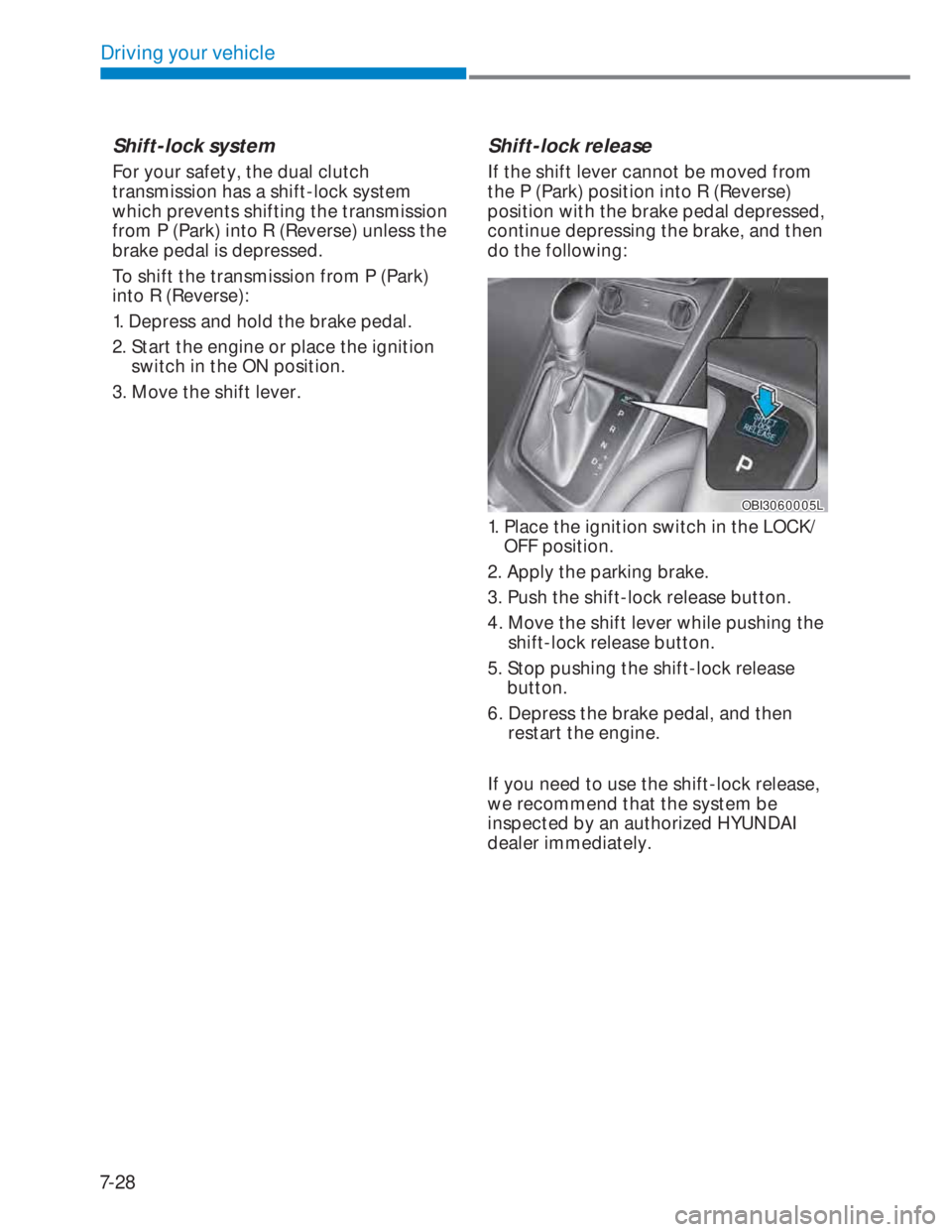
7-28
Driving your vehicle
Shift-lock system
For your safety, the dual clutch
transmission has a shift-lock system
which prevents shifting the transmission
from P (Park) into R (Reverse) unless the
brake pedal is depressed.
To shift the transmission from P (Park)
into R (Reverse):
1. Depress and hold the brake pedal.
2. Start the engine or place the ignition
switch in the ON position.
3. Move the shift lever.
Shift-lock release
If the shift lever cannot be moved from
the P (Park) position into R (Reverse)
position with the brake pedal depressed,
continue depressing the brake, and then
do the following:
OBI3060005LOBI3060005L
1. Place the ignition switch in the LOCK/
OFF position.
2. Apply the parking brake.
3. Push the shift-lock release button.
4. Move the shift lever while pushing the
shift-lock release button.
5. Stop pushing the shift-lock release
button.
6. Depress the brake pedal, and then
restart the engine.
If you need to use the shift-lock release,
we recommend that the system be
inspected by an authorized HYUNDAI
dealer immediately.